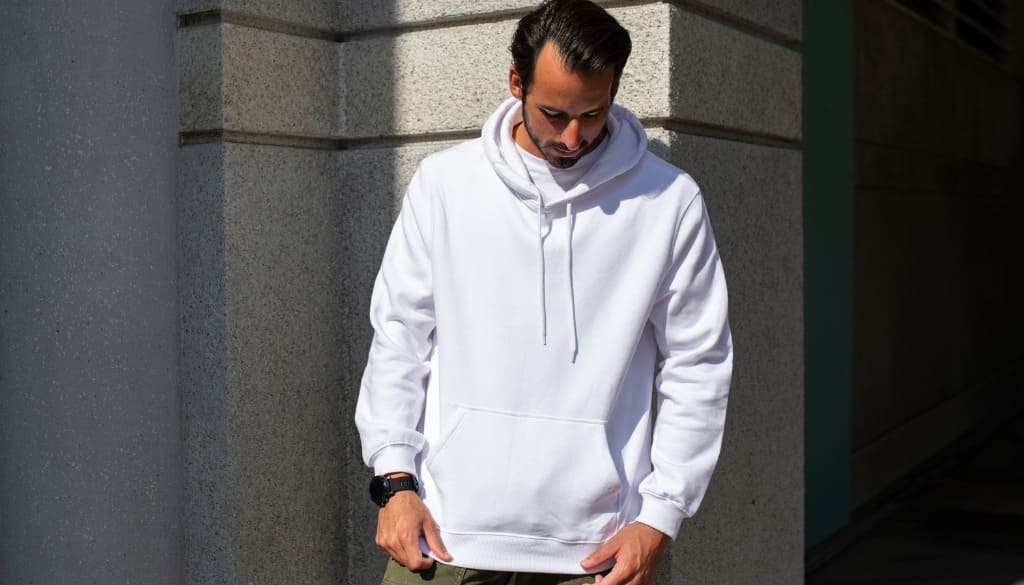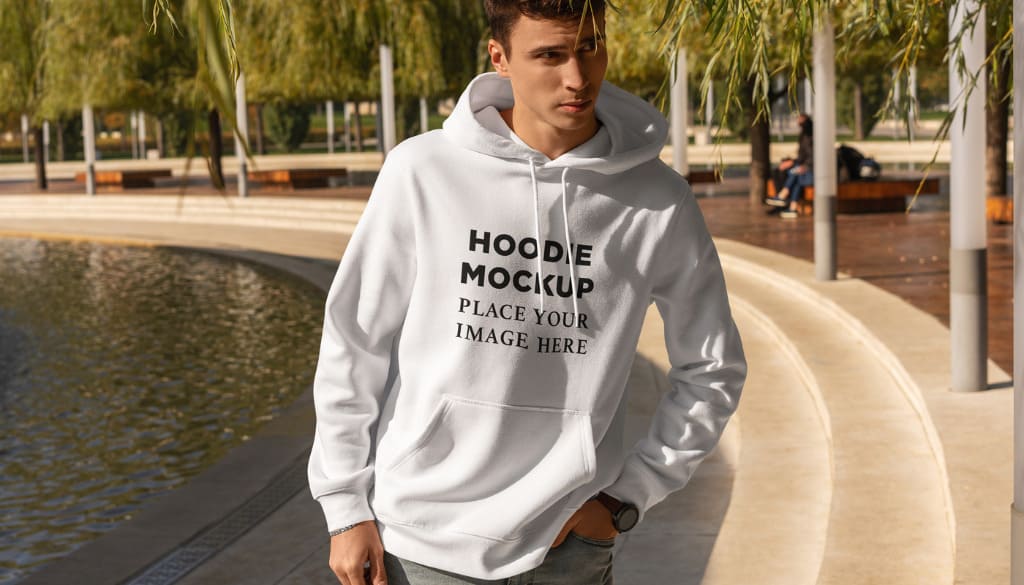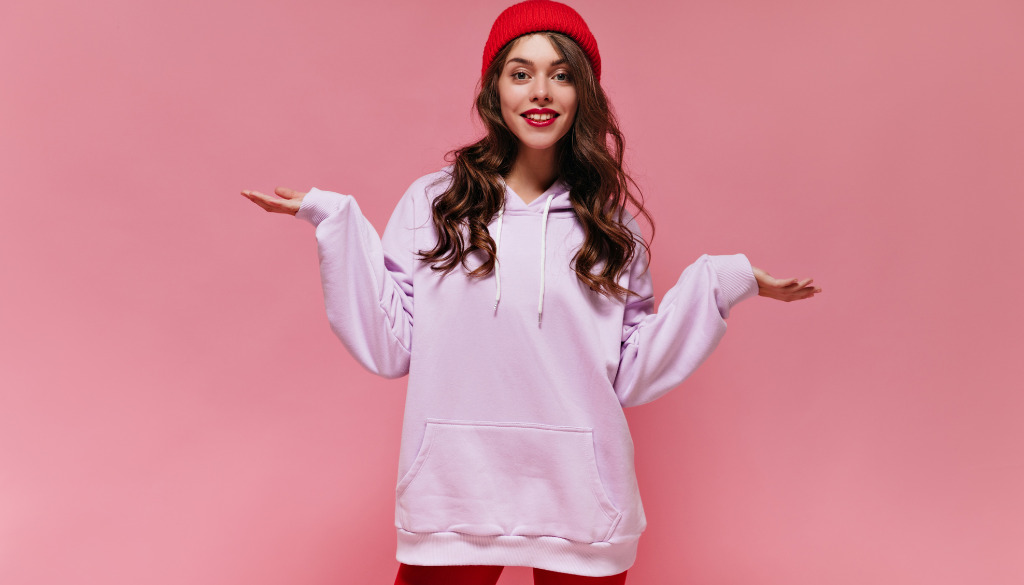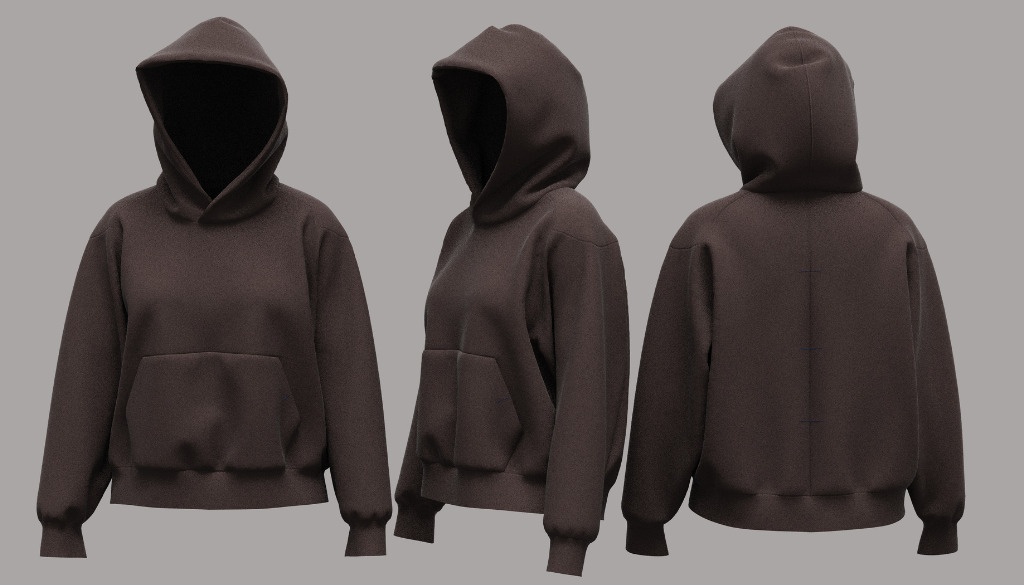Hoodie material not only provides comfort to the wearer and determines product durability but is also a critical factor influencing customers’ purchasing decisions. For POD sellers, understanding the strengths and weaknesses of each fabric type is the key to creating high-quality products that match customer preferences and enhance competitiveness in the market. In this article, FlashShip will explore popular hoodie materials in detail, analyze their pros and cons, and reveal how to choose the most suitable fabrics for effective business outcomes.
Introduction to Hoodies and the Importance of Material

Hoodies first appeared in the United States in the 1930s and were originally worn primarily by workers due to their convenience, comfort, and warmth. Over time, hoodies gradually became a popular fashion icon, especially among young people and within the streetwear community.
The fabric material plays a crucial role, determining nearly all of a hoodie’s value:
- Impact on comfort: Soft, breathable fabrics help wearers feel comfortable throughout the day.
- Product durability: High-quality hoodie materials are resistant to pilling, maintain shape well, and have a long lifespan.
- Aesthetics and printability: Good fabric quality results in sharp, durable prints, enhancing brand value and attracting customers.
Clearly understanding the role of materials enables sellers to make smart choices, optimize revenue and build a sustainable brand.
Popular Materials Used for Hoodies
Today, the market offers numerous materials used for manufacturing hoodies, each with distinct characteristics suitable for different purposes and styles. Below are the most common materials that POD sellers should thoroughly understand:
1. Cotton
Cotton is the most widely used natural fiber in the apparel industry and, undoubtedly, a “star” in the hoodie world. Cotton is renowned for its softness, excellent absorbency, and breathability, providing comfort when worn.
- 100% Cotton: This pure cotton fabric contains no synthetic fibers. Hoodies made from 100% cotton are extremely soft, skin-friendly, and highly absorbent. However, its downsides include susceptibility to wrinkling, shrinkage after washing, and longer drying times.
- Cotton Blend:To overcome the shortcomings of pure cotton and enhance desired properties, cotton is often blended with synthetic fibers such as polyester, spandex (elastane), and rayon.
- Cotton-Polyester (CVC – Chief Value Cotton or PC – Polyester Cotton): This is the most common combination, typically featuring higher cotton content (e.g., 60% cotton, 40% polyester) in CVC, or higher polyester content in PC. This blend makes hoodies less prone to wrinkling, more durable, better at retaining shape, and quicker drying compared to 100% cotton, while still maintaining relative softness and breathability.
- Cotton-Spandex: Adding a small percentage of spandex (about 2-5%) makes hoodies stretchy, fitted, and less likely to lose shape after use, offering maximum comfort during physical activity.
- Cotton-Rayon (Viscose): Rayon is a semi-synthetic fiber derived from wood cellulose, giving fabrics a smooth, soft, and natural drape. When blended with cotton, it creates a lightweight, breathable fabric with an attractive drape, ideal for relaxed-fit hoodies.
2. Fleece (Polar Fleece)
Fleece is not a natural fiber but rather a weaving technique, typically made from polyester, though sometimes blended with cotton or other fibers. Fleece fabric features a soft, fluffy surface on one or both sides, creating air pockets that effectively retain heat.
- Polyester Fleece: The most common type, polyester fleece is extremely warm, lightweight, fast-drying, and wrinkle-resistant. However, its breathability is inferior to cotton, potentially causing discomfort in hot weather or during intense activities. Polyester fleece also tends to generate static electricity and may feel somewhat synthetic or “plastic” to the touch.
- French Terry (Cotton Fleece): Also known as cotton fleece, this fabric combines cotton with a fleece knitting technique. Its outer surface is smooth, while the inner side consists of soft loops, creating warmth and insulation. French terry is an excellent choice for hoodies, as it provides fleece-like warmth but still maintains cotton’s softness, breathability, and absorbency. It’s less stuffy than polyester fleece and has a more natural feel.
3. Polyester

Polyester is a synthetic fiber well-known for its durability, wrinkle resistance, minimal shrinkage, and quick drying. In hoodies, polyester can be used alone or blended with other fibers.
- 100% Polyester: Hoodies made entirely of polyester are highly durable, water-resistant to some extent, and extremely quick-drying, making them suitable for athletic activities or damp environments. However, they’re less breathable than cotton, can feel stuffy, and do not absorb sweat as effectively.
- Polyester Blends: As mentioned earlier, polyester is frequently blended with cotton to combine the advantages of both fibers.
4. Rayon (Viscose)
Rayon, also known as viscose, is a semi-synthetic fiber made from wood cellulose. It provides a soft, smooth feel and a beautiful drape similar to silk. Rayon absorbs moisture better than polyester but less effectively than cotton.
- Advantages: Softness, elegant drape, breathable, relatively good moisture absorption, and luxurious appearance.
- Disadvantages: Prone to wrinkles, can shrink when washed, less durable compared to cotton and polyester, and can become fragile or damaged when wet. Rayon is often blended with other fibers to increase durability and reduce wrinkling.
5. Hemp
Hemp is a sustainable, environmentally friendly natural fiber. Hemp fabric is extremely durable, naturally UV-resistant, and antimicrobial.
- Advantages: Highly durable, breathable, antimicrobial, UV-resistant, eco-friendly, and becomes softer with each wash.
- Disadvantages: Initially can feel somewhat rough or stiff, more expensive than other fabrics, and less common. Often blended with cotton or other fibers to enhance softness.
6. Bamboo
Bamboo is another eco-friendly fabric made from bamboo fibers. It is renowned for its silky softness, natural antibacterial properties, and excellent moisture-wicking capabilities, helping regulate body temperature.
- Advantages: Soft texture, antibacterial, excellent moisture absorption, temperature-regulating, environmentally friendly, and UV-resistant.
- Disadvantages: Easily wrinkled, prone to stretching and losing shape if not properly blended or cared for, and relatively expensive.
Comparison of Popular Hoodie Materials
To help sellers visualize and make informed choices, the comparison table below summarizes key characteristics of the most common hoodie materials:
| Criteria | 100% Cotton | Cotton Blends (CVC/PC) | Polyester Fleece | French Terry (Cotton Fleece) | 100% Polyester |
| Softness | Very high, natural softness | High, soft, comfortable | Medium to high (depending on quality) | High, soft, smooth outer, looped inner | Medium, may have a slightly “plastic” feel |
| Warmth | Medium to high (depending on thickness) | Medium to high | Very high | High | Medium to high |
| Breathability | Excellent | Good | Poor | Good | Poor |
| Sweat Absorption | Excellent | Good | Poor | Good | Poor |
| Durability | Medium, prone to stretching/pilling if unblended | High, more durable and shape-retaining than 100% cotton | Very high, excellent abrasion resistance | High | Very high |
| Wrinkle Resistance | Poor, wrinkles easily | Better than 100% cotton | Excellent | Medium | Excellent |
| Quick Drying | Poor | Moderate | Very fast | Moderate | Very fast |
| Shrinkage After Washing | Possible without pre-treatment | Less than 100% cotton | Minimal | Less than 100% cotton | Minimal |
| Suitable Climate | Mild, moderately warm | Mild, moderately warm | Cold, very cold | Mild to slightly cool | Humid, damp, light rain, or demanding durability |
| Cost | Medium to high | Medium | Medium to low | Medium to high | Low to medium |
| POD Printability | Excellent for DTG, screen printing. Bright colors. | Good for DTG, screen printing. Bright colors, good adhesion. | Good for sublimation (on polyester). Limited DTG. | Good for DTG, screen printing. Bright colors, good adhesion. | Good for sublimation. Limited DTG on light fabrics. |
How to Identify and Care for Each Hoodie Material
Proper identification and care will keep your customers’ hoodies looking good and lasting longer.

1. How to Identify Different Materials
- Cotton: When burned, cotton ignites quickly with a yellow flame and smells like burning paper. The ash is soft and easily crumbles. When touched, cotton feels soft, warm, and wrinkles easily. When water is dropped on it, it absorbs quickly.
- Polyester: When burned, polyester shrinks and melts into hard, black beads with a strong smell of burning plastic. The ash is hard and difficult to crush. When touched, polyester feels smooth, cool, slightly stiff, and resists wrinkling. Water either does not absorb or absorbs very slowly.
- Fleece (especially Polyester Fleece): Has a soft, fluffy surface, feels lightweight and airy. When burned, it has characteristics and odors similar to polyester.
- French Terry (Cotton Fleece): Smooth outer surface with clearly visible loops on the inner side. When burned, characteristics and odors resemble cotton.
- Rayon: Burns quickly like cotton but smells like burning wood. Produces soft, gray ash. When touched, rayon feels extremely soft, smooth, drapey, and cool to the touch. Easily wrinkles and can become fragile when wet.
- Hemp: When burned, smells like burning paper, producing soft, gray ash. Initially rougher to the touch than cotton but extremely durable. Surface has distinct, longer fibers.
- Bamboo: When burned, it smells like burning paper, producing soft, gray ash. Extremely soft, smooth, silky, and cool to the touch.
2. Care Instructions
General Care Rules for Hoodies:
- Read the care label: Always check the manufacturer’s care instructions on the label before washing.
- Wash in cold water: Protects colors, minimizes shrinkage, and saves energy.
- Turn hoodie inside out for washing and drying: Reduces friction, protects prints, and preserves fabric surface.
- Use mild detergent, avoid harsh bleach: Maintains fabric durability and color vibrancy.
- Limit high-temperature drying: High heat can cause shrinkage, damage prints, and shorten garment lifespan. Air-drying naturally is best.
- Avoid ironing directly on printed designs: If ironing is necessary, use low heat and iron with the garment turned inside out.
Material-Specific Care:/h4>
- 100% Cotton: Prone to wrinkles; dry flat or hang properly to prevent shoulder stretching. Be careful when tumble drying to avoid shrinkage.
- Cotton Blends: More durable and less prone to wrinkles than 100% cotton. Can be tumble-dried at lower temperatures.
- Polyester/Fleece: Dries quickly; air dry in a well-ventilated area. Avoid high heat when washing or drying to protect fiber structure. Usually requires minimal ironing.
- French Terry: Wash similarly to cotton. Dry flat or hang to maintain shape.
- Rayon: Highly susceptible to wrinkling and can be damaged when wet if handled roughly. Hand-wash or machine-wash on gentle cycle using cold water. Dry flat to prevent stretching, and avoid excessive wringing.
- Hemp/Bamboo: Wash like cotton or hand-wash gently. Allow to air-dry naturally. Can be ironed at medium temperatures if needed.
Suggestions for POD Sellers When Choosing Hoodie Materials
For POD sellers, selecting the right hoodie material is critical for positioning products, attracting customers, and maximizing profits. Below are strategic suggestions to guide your choices:

1. Identify Your Target Audience and Intended Use
- Customers prioritizing comfort, softness, and natural feel:
Focus on 100% Cotton or French Terry (Cotton Fleece). These materials are perfect for individuals seeking maximum comfort for everyday wear, especially suitable for moderate climates. - Customers looking for durability, wrinkle-resistance, and quick drying:
Consider Cotton Blends (particularly Cotton-Polyester) or 100% Polyester. Ideal for those with active lifestyles who need hoodies that are durable, low-maintenance, and suitable for light sports activities. - Customers in colder climates requiring maximum warmth:
Polyester Fleece is the best choice here. Extremely warm, lightweight, and quick-drying, it’s perfect for harsh winters. - Customers focused on sustainability and eco-friendliness:
Explore Hemp or Bamboo. Although more expensive, these materials appeal to environmentally-conscious customers willing to pay a premium for ethical, low-impact products.
2. Consider Printing Capabilities
Printing capability is extremely important for POD sellers.
- DTG Printing: Works best on fabrics with high cotton content (ideally 80% or above, preferably 100% Cotton). Cotton fibers absorb DTG ink effectively, yielding vibrant colors, sharp images, and high durability. Printing on polyester or high-polyester blends may result in uneven colors, poor ink adhesion, and rapid fading.
- Sublimation Printing: Suitable only for 100% Polyester or fabrics with very high polyester content (at least 65–70%) in light colors. Sublimation ink bonds directly to polyester fibers, resulting in durable, crack-resistant, vibrant images.
- Screen Printing: Applicable to various materials, but best results for durability and ink adhesion are achieved on Cotton and Cotton Blends.
- DTF Printing: A newer technology applicable across nearly all fabric types, including Cotton, Polyester, Cotton Blends, Fleece, and French Terry. DTF supports complex details, vivid colors, high durability, and is not limited by fabric background color. It’s particularly ideal for diversifying product offerings.
Advice: If you seek flexibility in designs and printing techniques, especially for DTG or DTF with multiple colors and complex details, prioritize 100% Cotton, High-Cotton Blends (CVC), or choose DTF technology, ensuring excellent image quality across various materials.
3. Product Pricing and Profit Optimization:
- Premium Materials (100% Cotton, French Terry, Hemp, Bamboo): Usually incur higher material costs, allowing you to position your products in a premium market segment, targeting customers willing to pay more for superior quality and comfort.
- Mid-range Materials (Cotton-Polyester, Polyester Fleece): Offer a good balance between quality, durability, and affordability. These materials represent the safest and most popular choice suitable for a wide range of customers.
4. Diversify Your Product Portfolio
Rather than focusing solely on one material type, consider offering multiple options to meet the diverse needs of the market.
Example:
- A “Premium Comfort” hoodie line using French Terry or 100% Cotton.
- An “Everyday Durability” line with Cotton-Polyester blends.
- A “Performance” line featuring Polyester Fleece.
Selecting hoodie materials is not just a technical decision; it’s a strategic business choice. By thoroughly understanding each fabric’s strengths and weaknesses, carefully considering customer segments, printing capabilities, and pricing strategies, POD sellers can make intelligent decisions. This enables the creation of high-quality products that attract customers and build a strong, recognizable brand in the market.
For more information, contact us via hotline at (+84) 943 024 337 or visit our website at FlashShip.net for assistance!
Read more articles:

